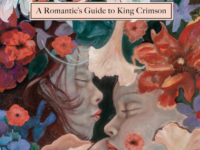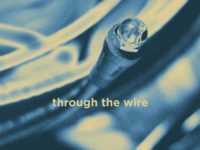The name Pat Mastelotto is a familiar one to those who peruse the credits of pop, rock and progressive albums. A member of King Crimson for 25 years, he’s also one third of Stickmen alongside fellow Crim Tony Levin and touch guitarist Markus Reuter, and he has graced recordings by everyone from Mr. Mister to Al Jarreau to XTC.
One of his favorite experiences is the Three of a Perfect Pair Camp held yearly (except 2020, of course) in the Catskills, featuring Mastelotto, Levin and former Crimson member Adrian Belew. King Crimson enthusiasts from across the country and the globe attend, gathering to play and hear a variety of music inspired by the iconic band.
Then the organizers introduced another element: the jazz café. That’s where the campers were introduced to the singing voice of Pat’s wife Deborah. Now, the duo has released a new studio project, A Romantic’s Guide to King Crimson.
“About five years ago, we added the jazz café,” Pat tells us. “I was walking across the field. A guy said, ‘Your wife has a beautiful voice. She sang at the jazz café.’”
That was news to Pat Mastelotto. While Deborah had sung in madrigal groups and the like, she’d never sung in front of her husband. “The important thing is Pat wasn’t in the room,” Deborah adds. “Once he realized I could sing, there was another voice in the drum room.
“Pete [Levin]’s addition of the jazz café to our camp lineup was what changed the camp for me,” she continues, referring to bassist Tony Levin’s brother, who plays keyboards and French horn. “I don’t think our record would have happened without it or him.”
Deborah, of course, was well aware of the Crimson catalog. “I got to know the songs and melodies. Some were sentimental,” she notes.
The two began to casually collaborate. Prior to the onset of the pandemic, they’d discussed doing some recording together, including original takes on King Crimson material. “We talked about it pre-COVID,” Pat says.
With the shutdown came the opportunity to do – well, something. “It’s what I do, I make music – specifically recording,” he says. “That’s been my life mission since I was a teenager – touring, rehearsing too, but really starting with nothing and recording something I can enjoy listening to is my high.
“I’ve set myself up to do it from home at my own pace. It’s like my puzzle game, my indoor activity,” Pat adds. “When everything stopped, we could work on things. We didn’t just do it on a whim. With COVID, we had time and space.”
For her part, Deborah began delving even more deeply into the band’s back catalog. She used an app called Amazing Slow Downer, which can modify the tempo of a song and the pitch independently. She then purchased all the King Crimson downloads she could find.
“I began this obsessive listening and messing with the songs, slowing them down, changing the pitch, just playing around,” she says. “Then I’d drag Pat into it – ‘Here, listen to this!’ He’s always busy working on one kind of music or another, so his brain works like that anyway, and he was always interested.”
They began listening to the originals and to as many cover versions as they could find, from instrumentals such as those by former King Crimson drummer Ian Wallace’s Crimson Jazz Trio (“I’ve been listening to the Crimson Jazz Trio for at least 10 years,” Deborah says) to orchestral, rock and other jazz renditions. That gave them a taste of what could be done with the music, and the seeds of A Romantic’s Guide to King Crimson were planted.
“Pat’s studio is in our home, [and] I hear him disassemble and reassemble these songs,” Deborah says. “So, I knew that Crimson songs were malleable.
“I don’t play an instrument. I sing,” she added. “So of course, the lyrics would get stuck in my head after hearing them so many times. I started to search for the full lyrics off the internet. Without the instruments, they felt sweet, some of them – even corny.”
Given the multitude of songs in the King Crimson catalog, there was plenty to choose from. “We tried not to be predictable,” Deborah says. That led to choices such as “Heartbeat,” “Inner Garden,” even “Elephant Talk,” alongside more likely selections like “Moonchild” and “Book of Saturday.”
Perhaps even more intriguing than the individual selections were the arrangements. Tempos were slowed, sometimes to the point of a glacial pace. Out were electric guitars; in were trumpet, synthesizer, oboe, flute, harp. A number of musicians from the Three of a Perfect Pair camps were enlisted.
It adds up to a complete reimagining of the music of King Crimson. Lush sounds, downtempo, gauzy vocals, and virtually no guitar. “We were not set up as a lounge band,” Pat Mastelotto says.
Does A Romantic’s Guide to King Crimson work? They think so. “When we were mastering it, we’d go for a drive and listen on the car stereo,” Deborah says. “We’d time it so the sun was setting. There was a visceral reaction.”
- Gregory Porter, Samara Joy, John Paul McGee + Others: 2023’s Seasonal Sounds - November 30, 2023
- John McLaughlin’s Shakti – ‘This Moment’ (2023) - July 14, 2023
- Rolling Stones – ‘GRRR Live!’ (2023) - March 30, 2023




